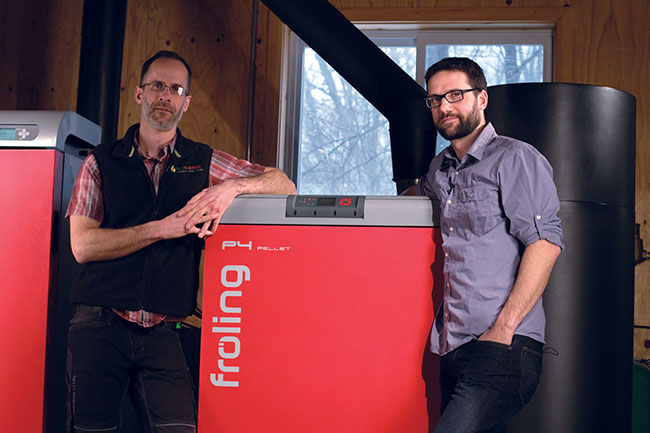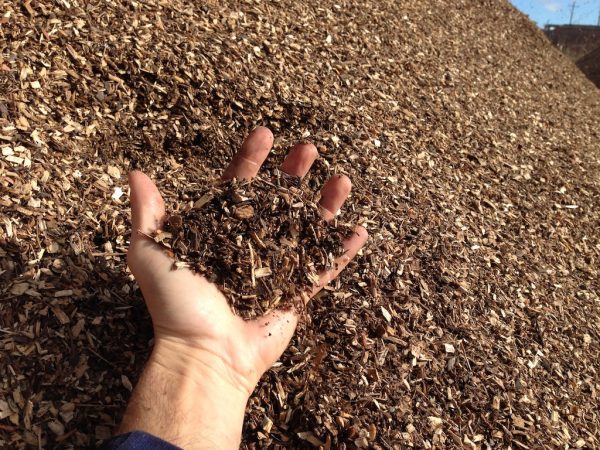
Chipping in: Biothermic looks to rebuild forestry sector using wood chips
October 29, 2019
By Meagan Ross
 Brothers Mike (left) and Vince Rutter founded Biothermic Renewable Energy Systems, and recently built Ontario’s first energy wood chip production and storage facility. Photo courtesy Biothermic Renewable Energy Systems.
Brothers Mike (left) and Vince Rutter founded Biothermic Renewable Energy Systems, and recently built Ontario’s first energy wood chip production and storage facility. Photo courtesy Biothermic Renewable Energy Systems. Vince Rutter is clearly in the right line of work. “I like to grow things,” he says when asked about his penchant for starting businesses. In fact, he and his brother, Mike, recently started a new business, Biothermic Renewable Energy Systems, and built Ontario’s first energy wood chip production and storage facility.
But this isn’t Vince’s first foray into the forest products sector. After graduating from Lakehead University’s Forestry program in Thunder Bay, Ont., he worked for a local forestry company before striking out on his own in 2005, creating Rutter Urban Forestry (RUF). Through RUF, he shares his passion for good tree care, providing clients with treatments to keep trees healthy, and educating people on the benefits of urban forests and environments. RUF also produces waste-wood chips from their tree care work.
After building RUF for 10 years, a local opportunity with Confederation College arose, which helped launch Biothermic. Biothermic offers in-demand expert wood heating knowledge and experience, wholesale mechanical distribution, complete design support and turnkey installations of wood heating systems for commercial, institutional and residential customers.
Biothermic took off after the Rutters met with staff at the college’s Bioenergy Learning and Research Centre, where two Fröling 500 kW heating units had been installed to heat the main campus buildings, along with a 150 kW research boiler, a 15 kW pellet boiler and a 30 kW firewood boiler, all made by Fröling.
According to Rutter, smaller modern biomass boilers, such as the ones the college installed, present a challenge since they require a refined type of wood chip not available from typical forestry companies. In this case, the college also wanted to burn low grade waste-wood products, which are in ample supply from urban forests, RUF’s area of expertise.
Thus, the college’s new heating system highlighted the natural synergy between RUF and Biothermic: RUF needed to divert its waste-wood chips and Biothermic needed a reliable wood chip supply in order for clients to install wood chip heating systems. The success of the college’s biomass boilers relied on the stable supply of fuel created through this partnership.
A first for Ontario
This past year, Biothermic capitalized on this partnership and built Ontario’s first energy wood chip production and storage facility in Thunder Bay. The new 5,000 square-foot facility, which took about one month to build, provides 200,000 cubic metres of storage space, and can reliably produce and store graded fuel at less than 30 per cent moisture content (MC). The chips from RUF are screened and dried at Biothermic’s new facility until they reach the P45 W30 grade, making them compatible with many European-made wood chippers.
When asked what prompted the ambitious project, Vince explains that it was essential to have the infrastructure in place in order to build capacity – the facility had to be built and functioning in order to attract clients to wood heating. But without a reliable source of fuel, he would be hard pressed to convince institutions and businesses to convert.
To help make the new wood processing facility a reality, the Centre for Research and Innovation in the Bio-Economy (CRIBE), an independent non-profit corporation that supports the development and commercialization of innovative use of forest biomass in Canada, awarded Biothermic a $168,500 grant.

Wood chips stored at Biothermic’s energy wood chip production and storage facility in Thunder Bay, Ont. Photo courtesy Biothermic Renewable Energy Systems.
From waste to warmth
Typically, wood chips come from sawmill or forest operation residues, but the urban forest is also an important source. Usually urban wood waste is used for compost or mulch, or dumped in a landfill. But almost all of Biothermic’s chips are used for energy.
Modern wood heating systems need relatively uniform wood chips to be compatible with small-scale boilers, which enable them to flow through augers. Biothermic produces heating chips that meet ISA/CSA 17225-4 standards, a requirement for small-scale chip heating.
The process for producing these heating chips is fairly straightforward. Chips arrive at Biorthermic’s Thunder Bay facility from RUF’s tree care trucks. They are then put into a three-deck screening plant, which removes the large pieces and the small particles, as well as dust.
The screener, manufactured by Assinck, cost about $130,000, but required some modifications to handle wood chips instead of aggregate. The screen oscillated vertically, rather than horizontally (which is typically preferred), but still effectively creates P45-grade fuel. Since wood chips are more difficult to move in bulk than sand or gravel, Biothermic installed an agitator and adjusted screen sizes to find the best flow for highest productivity, Vince explains.
This process only works for chipped wood, not ground wood products, he adds. It is intended to process materials from smaller hand-fed wood chippers (eight to 22 inches in diameter).
The green wood chips that Biothermic receives from RUF have a MC of 50 per cent or higher, and need to be dried to 35 per cent or less to be used for heating. At Biothermic, this is done organically in a storage tent – the natural process of decomposition creates heat and dries the wood chips to 20 to 25 per cent MC.
Vince notes that the risk of combustion is extremely low as pile sizes are kept to a minimum and pile heating ceases as MC drops below 30 per cent. Biothermic manages combustion risk by ensuring piles are not more than approximately five metres high and green chips are not compacted. Interior pile temperatures are consistently in the low 40 C range. As the MC of a pile drops, temperatures drop and, consequently, combustion risk also drops. Studies have shown that combustion risk increases with higher pile sizes, compacted piles (such as when a bulldozer is used to manage a pile) and where poplar bark content is high. In reality, the biggest risk is from cigarette butts from property neighbours, Vince says.
The tent in which the chips are stored covers 10,000 square feet of pavement. It was supplied by Winkler Structures and is a double truss canvas tent anchored on two rows of two feet tall concrete lock blocks. The cost to erect the tent and pave the ground was approximately $150,000. Only chips of the desired size (45 to 50 millimetres) are put into the tent.
Critically, Vince says, the processing plant and storage facility gives Biothermic and its customers enough room to accumulate chips in the spring, summer and fall for use for the entire winter heating season.
Biothermic can ship fuel anywhere in Northern Ontario, Vince says. But providing clients outside of Thunder Bay with wood chips is limited by hauling distance. For wood chip heating systems that are further away, Biothermic can supply a wood chipper made by Pezzolato of Italy, which circumvents the need for a screener and storage facility. However, Vince acknowledges that the wood chipper does not work for urban waste wood, as fibre can come from multiple companies with multiple chipper types, which would require a screener.
Vince believes it is always better to keep fuel local to reduce shipping costs and keep local jobs, so this business model has limited regional reach, but serves as a learning tool and a model for other provinces.
The Thunder Bay facility also allows regional projects to use Biothermic as a secondary source of wood chip fuel if they have trouble sourcing it another way.
The smart alternative
While Vince and Mike are certainly excited about what they’ve accomplished so far through Biothermic, their eyes really light up when they talk about the opportunities that modern wood heating offers Canadians.
Canada has the most sustainably managed forest resources per capita of any country and is an international leader in sustainable forestry, but, by all measures, has not yet realized the economic and environmental potential of this renewable resource, Vince says. Fossil fuels continue to be the favoured fuel source for heating.
When they started Biothermic, the Rutters looked to the European market for inspiration. Europeans have been realizing the benefits of wood fuel heating systems for decades. Their success is proof that using wood to meet Canada’s energy needs is a viable option.
“Canada is a cold country, with vast forests and no technological barriers when it comes to heating with wood,” Vince says. He believes that heating with wood is “the right thing to do.” The advantages to using wood for heating seem obvious: it offers individuals and corporations the opportunity to reduce greenhouse gas (GHG) emissions and save money compared to using fossil fuels, all while building a local workforce to keep money in Canada – a triple bottom line.
And word is spreading about these heating systems. As a result of its collaboration with Confederation College, Biothermic has installed a 150 kW Froling wood chip system at a local greenhouse to eliminate propane consumption and extend the typically short growing season in the North.
This heating season will also see three Ontario First Nations installing identical systems with a Pezzolato chipper supplied by Biothermic. These remote communities, surrounded by productive forests, have a keen interest in learning how to decrease their reliance on fossil fuels with self-sustaining systems like the ones Biothermic offer, Vince explains. These five systems translate to over two MW of wood chip heating in Northwestern Ontario.
But there are still multiple hurdles in making the switch to wood heating on a larger scale, such as lack of public knowledge and capacity building.
What’s next?
The Rutters acknowledge that small-scale biomass companies encounter the “chicken and egg” dilemma: start-ups need an anchor client or a critical mass of smaller clients to justify investments in feedstock supply and infrastructure, but they also need an existing supply and infrastructure for clients to confidently invest in wood heating systems. Still, they hope that other companies will take the business model they have created and replicate it throughout North America to build a renewable energy sector that rivals the one in Europe.
Moreover, Vince believes that with more confidence in the technology and education about the benefits of wood chip heating, businesses, institutions and homeowners will embrace wood as the right choice for heating. For projects like Biothermic’s energy chip production and storage facility to materialize, and to create more jobs and increase energy affordably and sustainably, “brave ambassadors are needed; people who are willing to take a small risk and have a passion for renewable energy to show others that wood as an energy source really is a win-win,” he says. •
Meagan Ross is the communications advisor for Biothermic Renewable Energy Systems.
Print this page